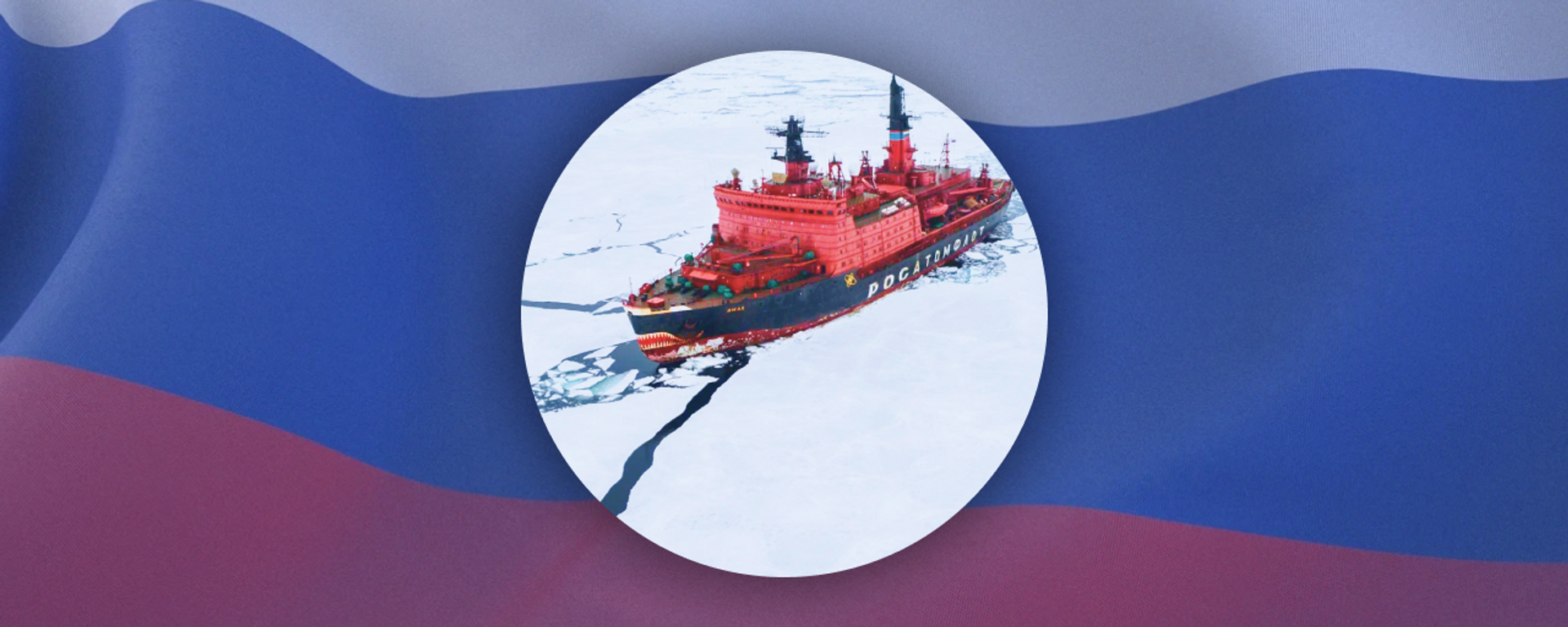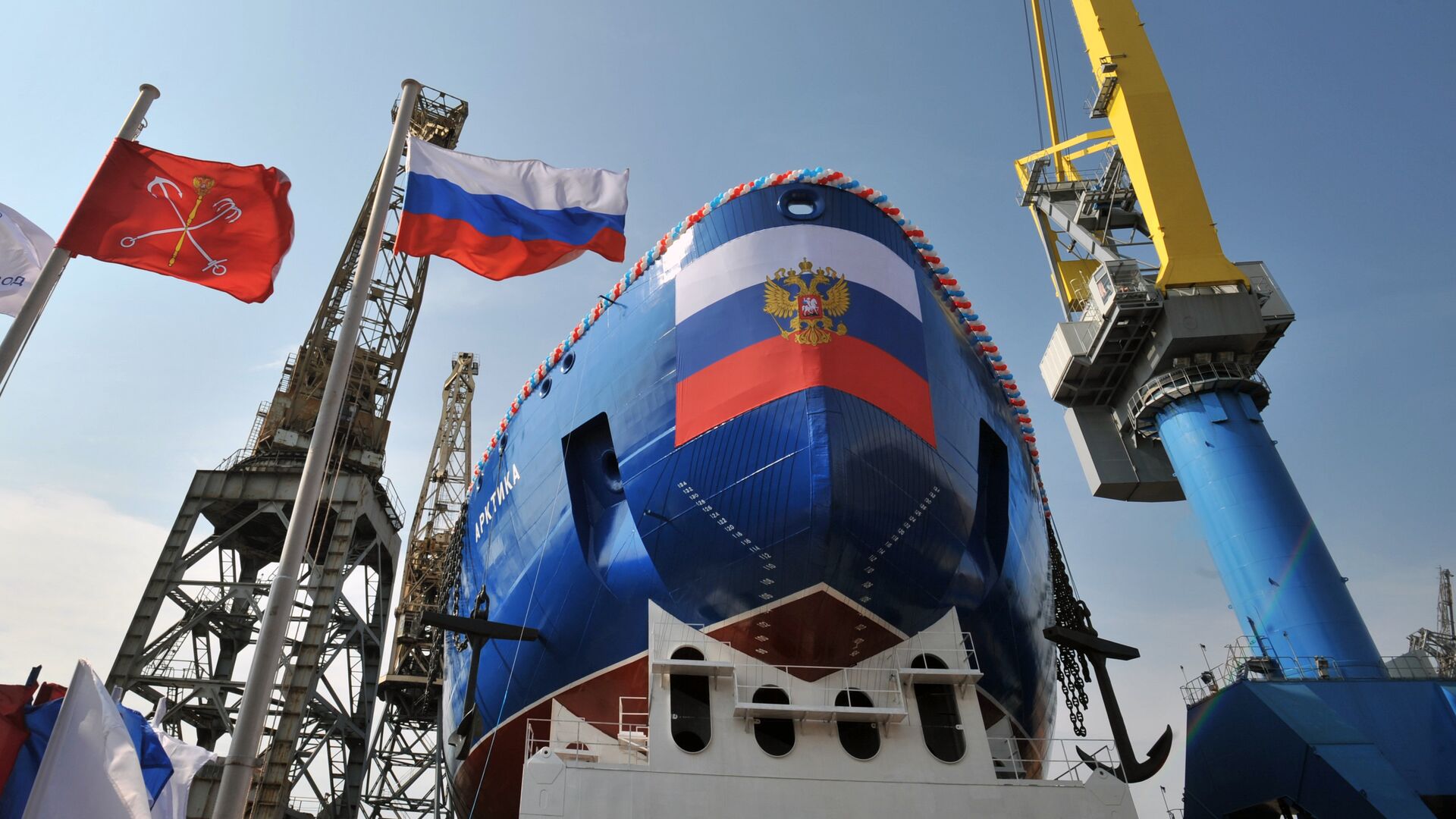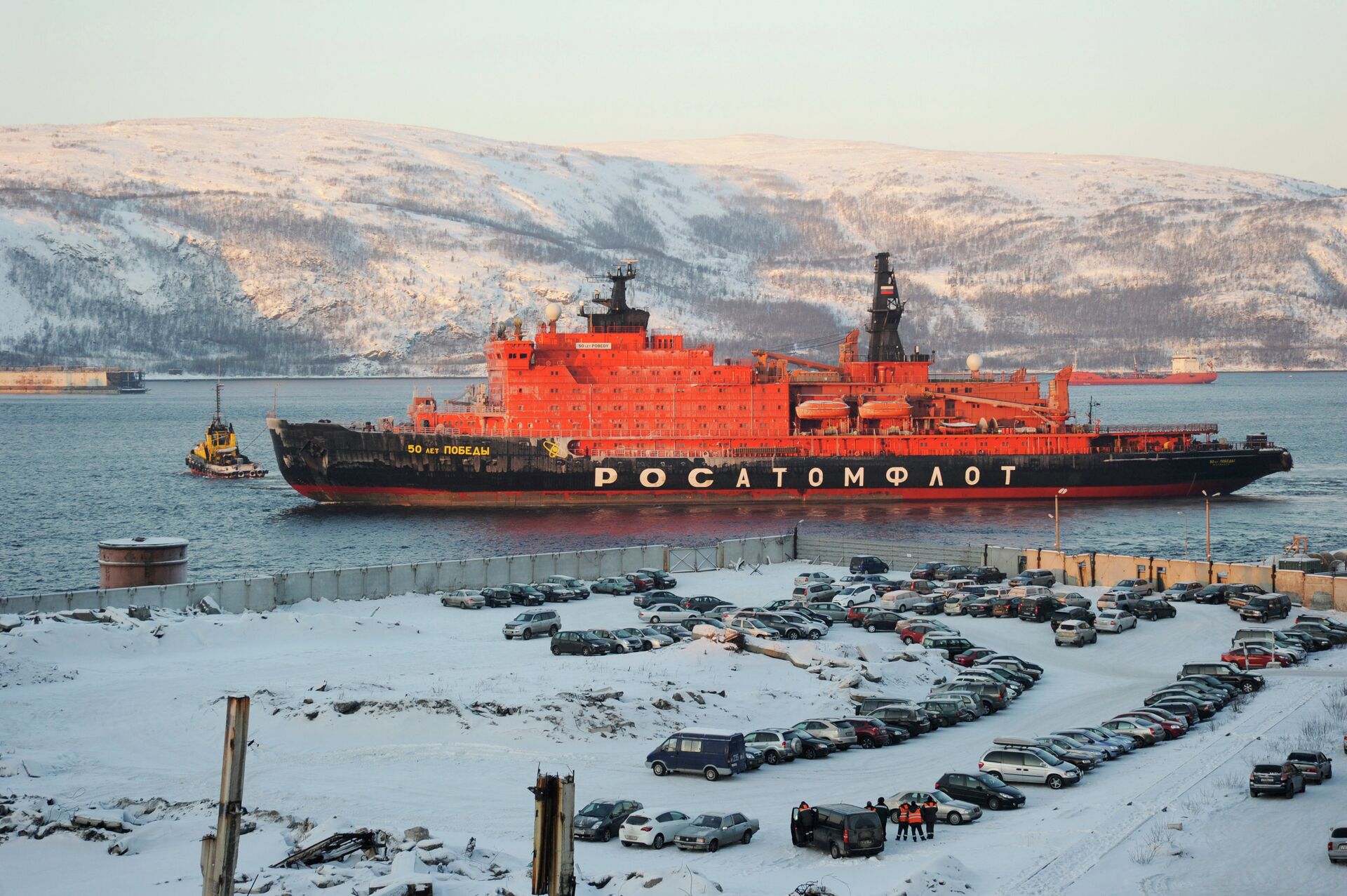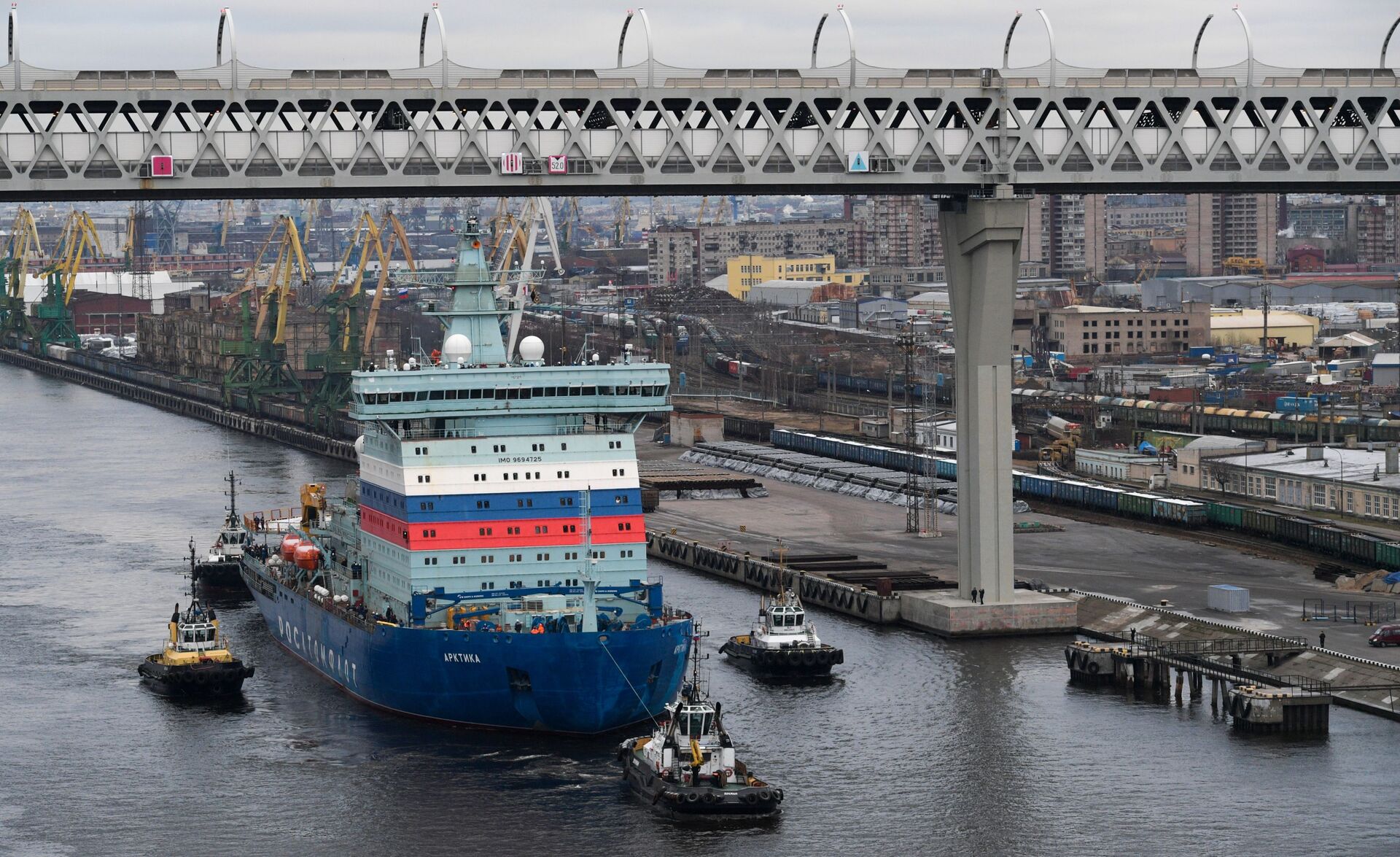https://sputnikglobe.com/20231203/atomic-might-russia-toasts-nuclear-powered-icebreaker-fleet-1115358750.html
Atomic Might: Russia Toasts Unrivaled Nuclear-Powered Icebreaker Fleet
Atomic Might: Russia Toasts Unrivaled Nuclear-Powered Icebreaker Fleet
Sputnik International
The world’s first nuclear-powered icebreaker, “Lenin”, which is also considered the first nuclear-powered civilian ship in the world, was built in the Soviet Union and officially entered into service on December 3, 1959.That date marked the beginning of the Soviet/Russian nuclear-powered icebreaker fleet, the most numerous and potent of its kind on the planet.
2023-12-03T17:17+0000
2023-12-03T17:17+0000
2023-12-03T18:28+0000
russia
russia
arctic
northern sea route
baltic shipyard
viktor litovkin
nuclear power
icebreakers
https://cdn1.img.sputnikglobe.com/img/104331/89/1043318909_0:39:3448:1979_1920x0_80_0_0_6ccc289aa3f167818ac8fc75c78ff241.jpg
The world’s first nuclear-powered icebreaker, “Lenin”, which is also considered the first nuclear-powered civilian ship in the world, was built in the Soviet Union and officially entered into service on December 3, 1959.That date marked the beginning of the Soviet/Russian nuclear-powered icebreaker fleet, the most numerous and potent of its kind on the planet.Russia constructed these powerful vessels to facilitate the flow of maritime traffic through the Russian Arctic waters, along what is currently known as the Northern Sea Route.While the less-powerful diesel icebreakers often could not take on thick ice slabs during early spring or late autumn, not to mention that refueling these ships amid the ice-encased sea was nearly impossible, nuclear-powered icebreakers could accompany caravans of cargo vessels for as long as it was necessary, smashing all icy obstacles in their path.Despite “Lenin” being decommissioned in 1989, it has since been succeeded by a number of even more powerful and advanced vessels.Between 1971 and 1972, five nuclear-powered icebreakers – “Arktika” (decommissioned in 2008), “Sibir” (decommissioned in 1992), “Rossiya” (decommissioned in 2013), “Sovetskiy Soyuz” (decommissioned in 2014) and “Yamal” (still in operation) – were built at the Baltic Shipyard in St. Petersburg.Two nuclear-powered icebreakers, “Taymyr” and “Vaygach,” were built during the 1980s for the USSR in Finland, with Soviet steel and equipment (such as the propulsion unit) being used in the construction.Also in the 1980s, the Zaliv Shipyard in Kerch produced a truly unique vessel called “Sevmorput,” a nuclear-powered cargo vessel that could also perform as an icebreaker.The “50 Let Pobedy” nuclear-powered icebreaker was proposed in 1989 but completed only in 2007 due to its construction being halted in the 1990s.By 2022, the Baltic Shipyard had also rolled out three new Project 22220 icebreakers – “Arktika,” “Sibir” and “Ural” – with several more vessels of its class currently being under construction.The lead vessel of the Project 10510 icebreakers, named “Rossiya,” is expected to join the ranks of the Russian nuclear-powered icebreaker fleet in 2027.At this time, Russia’s nuclear-powered icebreakers are the most advanced in the world, explained Victor Litovkin, a military analyst and retired colonel of the Russian Armed Forces.According to Litovkin, Russian nuclear-powered icebreakers play a vital role in facilitating maritime traffic along the Northern Sea Route, not to mention that these vessels afford access to the rich natural resources deposits hidden beneath the Arctic ice.“The northern territories contain vast deposits of rare earth elements, oil and natural gas. For example, 22% of world’s deposits of oil and gas are located in our Arctic,” he explained.Some of Russia’s more prominent liquefied natural gas (LNG) deposits, such as the Arctic LNG 1 and 2 projects, are also located in the country’s northern reaches, and the country’s nuclear icebreakers thus help export Russian LNG arrive via the Northern Sea Route.The analyst likewise warned that the riches of the Russian Arctic attract the unwanted attention of “aggressors” like the United States.That said, the lack of a potent icebreaker fleet would pose a hindrance to such US plans, whereas Russia’s nuclear-powered icebreakers afford Moscow the ability to maneuver its own naval assets in the Arctic and to resupply Russian military garrisons in this strategic region.
https://sputnikglobe.com/20231203/russias-one-of-a-kind-nuclear-icebreaker-fleet-in-numbers-1115363268.html
russia
arctic
Sputnik International
feedback@sputniknews.com
+74956456601
MIA „Rossiya Segodnya“
2023
News
en_EN
Sputnik International
feedback@sputniknews.com
+74956456601
MIA „Rossiya Segodnya“
Day of the Russian Nuclear Icebreaker Fleet
Sputnik International
Day of the Russian Nuclear Icebreaker Fleet
2023-12-03T17:17+0000
true
PT0M54S
Sputnik International
feedback@sputniknews.com
+74956456601
MIA „Rossiya Segodnya“
russia nuclear icebreakers, russia nuclear-powered icebreakers, how many nuclear icebreakers does russia have
russia nuclear icebreakers, russia nuclear-powered icebreakers, how many nuclear icebreakers does russia have
Atomic Might: Russia Toasts Unrivaled Nuclear-Powered Icebreaker Fleet
17:17 GMT 03.12.2023 (Updated: 18:28 GMT 03.12.2023) Russia is the only country in the world that operates a fleet of nuclear icebreakers, which allows Moscow to maintain its presence in the Arctic region whose strategic and geopolitical importance has been steadily growing over the years.
The world’s first nuclear-powered icebreaker, “Lenin”, which is also considered the first nuclear-powered civilian ship in the world, was built in the Soviet Union and officially entered into service on December 3, 1959.
That date marked the beginning of the Soviet/Russian nuclear-powered icebreaker fleet, the most numerous and potent of its kind on the planet.
Russia constructed these powerful vessels to facilitate the flow of maritime traffic through the Russian Arctic waters, along what is currently known as the Northern Sea Route.
While the less-powerful diesel icebreakers often could not take on thick ice slabs during early spring or late autumn, not to mention that refueling these ships amid the ice-encased sea was nearly impossible, nuclear-powered icebreakers could accompany caravans of cargo vessels for as long as it was necessary, smashing all icy obstacles in their path.
Despite “Lenin” being decommissioned in 1989, it has since been succeeded by a number of even more powerful and advanced vessels.
Between 1971 and 1972, five nuclear-powered icebreakers – “Arktika” (decommissioned in 2008), “Sibir” (decommissioned in 1992), “Rossiya” (decommissioned in 2013), “Sovetskiy Soyuz” (decommissioned in 2014) and “Yamal” (still in operation) – were built at the Baltic Shipyard in St. Petersburg.
Two nuclear-powered icebreakers, “Taymyr” and “Vaygach,” were built during the 1980s for the USSR in Finland, with Soviet steel and equipment (such as the propulsion unit) being used in the construction.
Also in the 1980s, the Zaliv Shipyard in Kerch produced a truly unique vessel called “Sevmorput,” a nuclear-powered cargo vessel that could also perform as an icebreaker.
The “50 Let Pobedy” nuclear-powered icebreaker was proposed in 1989 but completed only in 2007 due to its construction being halted in the 1990s.
By 2022, the Baltic Shipyard had also rolled out three new Project 22220 icebreakers – “Arktika,” “Sibir” and “Ural” – with several more vessels of its class currently being under construction.
The lead vessel of the Project 10510 icebreakers, named “Rossiya,” is expected to join the ranks of the Russian nuclear-powered icebreaker fleet in 2027.

3 December 2023, 18:27 GMT
At this time, Russia’s nuclear-powered icebreakers are the most advanced in the world, explained Victor Litovkin, a military analyst and retired colonel of the Russian Armed Forces.
“No other country in the world has so many nuclear-powered icebreakers,” he told Sputnik. “The US is trying to build its first nuclear-powered icebreaker but cannot get it done. Meanwhile, Russia has 11 nuclear-powered icebreakers, seven of which are operational, which constantly operate at the Northern Sea Route, escorting ships there. Nothing in the world can match Russian icebreakers with their power and ability to crush Artic ice about 2.5 meters thick.”
According to Litovkin, Russian nuclear-powered icebreakers play a vital role in facilitating maritime traffic along the Northern Sea Route, not to mention that these vessels afford access to the rich natural resources deposits hidden beneath the Arctic ice.
“The northern territories contain vast deposits of rare earth elements, oil and natural gas. For example, 22% of world’s deposits of oil and gas are located in our Arctic,” he explained.
Some of Russia’s more prominent liquefied natural gas (LNG) deposits, such as the Arctic LNG 1 and 2 projects, are also located in the country’s northern reaches, and the country’s nuclear icebreakers thus help export Russian LNG arrive via the Northern Sea Route.
The analyst likewise warned that the riches of the Russian Arctic attract the unwanted attention of “aggressors” like the United States.
“For one, the Northern Sea Route, our Arctic, is the closest route from Russia’s territory to the United States. And the US really wants to enter into our Arctic Ocean to deploy their destroyers there,” Litovkin said, noting that these US ships could pose a threat to Russian strategic missile bases in Siberia.
That said, the lack of a potent icebreaker fleet would pose a hindrance to such US plans, whereas Russia’s nuclear-powered icebreakers afford Moscow the ability to maneuver its own naval assets in the Arctic and to resupply Russian military garrisons in this strategic region.





